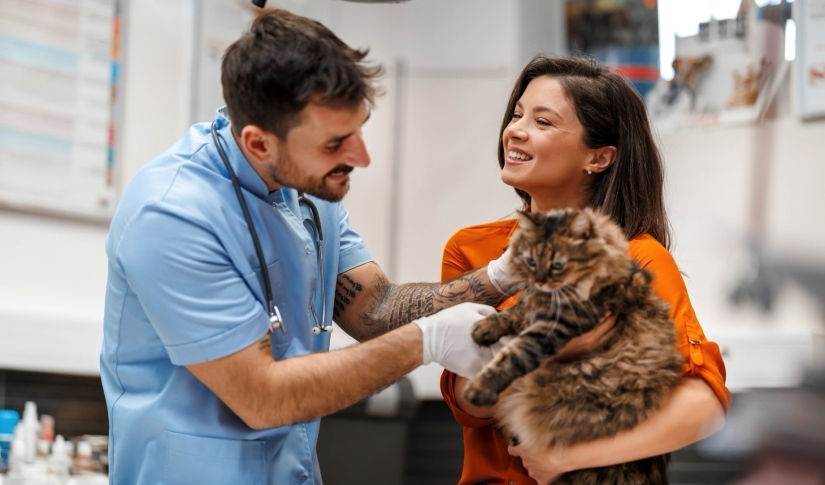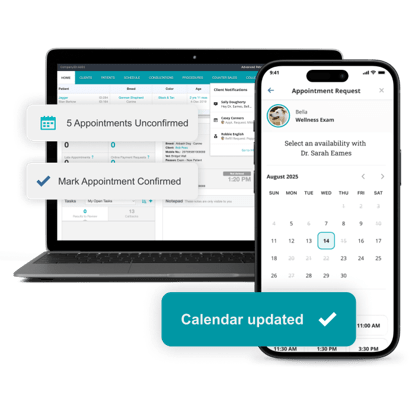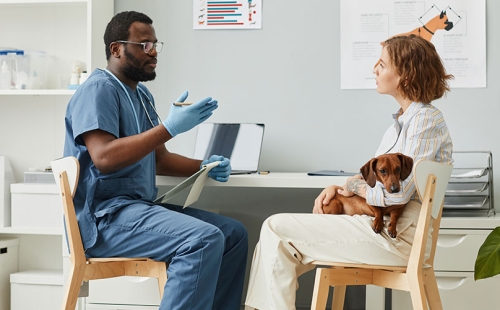5 Tools to Improve Veterinary Client Communication in 2025

Improving client communication is key to veterinary practice success in 2025. Client expectations are higher than ever, the economy is expected to slow, and veterinary teams are busy and burnt out, but client relationships can help overcome these challenges.
The right communication tools and technology can help you navigate missed appointments, reduce team burnout, and improve client satisfaction through a streamlined, digital experience. Happy clients mean happy pets and, ultimately, better pet care.
A few smart updates can transform how your team connects with pet owners. Here are five essential client communication tools that veterinary professionals should embrace in 2025 to build stronger relationships and more efficient veterinary clinics.
1. Automation
Appointment reminders are your best defense against no-shows, missed appointments, and cancellations. However, they’re tedious and time-consuming for the staff. Automated reminder systems alleviate this burden and offer customization options to suit veterinarian preferences. Personalized messages that reach clients at the right times and across multiple devices or platforms are more likely to get through to them than a voicemail, and they protect your team’s valuable time.
Automation integrated with your practice management system is the ideal option. A cloud-based system allows integrations with multiple platforms, so you can easily switch if your needs change.
2. Mobile app
In 2025, most businesses have an app. Pet owners expect the convenience of using an app for communication and other routine tasks, such as prescription refills, lab results, or medical record downloads. A mobile app is also a great way for clients to feel more connected to the team and to submit questions anytime.
A mobile app reduces client phone calls because it allows them to handle many routine requests themselves, bypassing the front desk team. Plus, when clients communicate with your cloud-based practice management software, you can build a communication history.
3. Telemedicine
Virtual care is a core component of modern veterinary client communication. Offering telemedicine allows your practice to meet pet owners where they are and alleviates scheduling bottlenecks by reducing patient numbers in the clinic.
Telemedicine is especially valuable for clients in rural areas, busy professionals, and anxious pets who don’t do well with in-person visits. It can also help you capture revenue from the consultation-like calls and texts you’re already handling but not charging for. Look for a platform that integrates with your PIMS so teams handling telemedicine communications can work from within their familiar dashboards and easily transfer visit documentation.
Telemedicine doesn’t replace real-time exams, but for specific client needs, it can support animal health, enhance the client experience, and give your team more control over their day.
4. Client education
Education is a client communication tool that never goes out of style. In 2025, focus on expanding education efforts with new, engaging content like videos, blog posts, and social media stories. Create educational materials clients can access from your website, mobile app, portal, or social media pages, which can also serve as valuable marketing tools.
Education is necessary for clients to understand recommendations and common health conditions. Without it, compliance can drop, as can patient healthcare outcomes. Plus, increasing client engagement improves the overall client experience and strengthens trust in the veterinary-client relationship.
5. Smart scheduling
Your front desk shouldn’t have to play calendar “Tetris” whenever a new client calls. Appointment scheduling tools that allow online booking give clients the autonomy and convenience they crave. Scheduling tools typically integrate well with existing software to streamline client communication, including reminders and follow-ups.
Use scheduling tools to optimize workflows. Set appointment rules, including length, spacing, and allowable times of day based on the appointment type the client chooses. Consider reserving more time for appointment types that might require diagnostics to reduce wait times and improve flow based on staffing.
Excellent communication with pet owners drives client loyalty and trust. Patient care is the priority, but the client experience will keep pet owners coming back. Adopting tools that optimize your team’s time, eliminate bottlenecks, and meet modern client needs sets your veterinary practice up for long-term success in 2025 and beyond.




